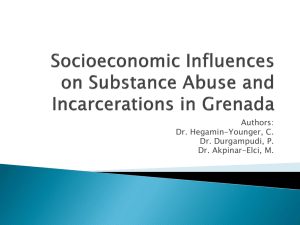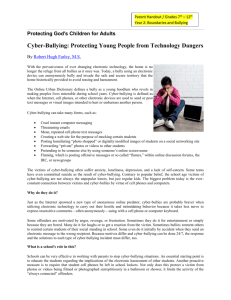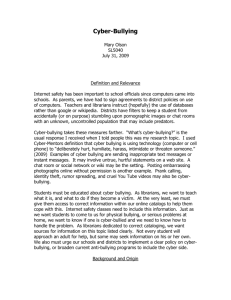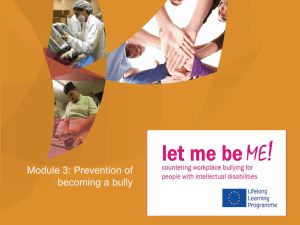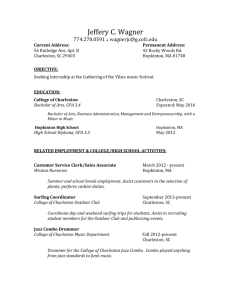2012-13 MWAHS Presentation
advertisement
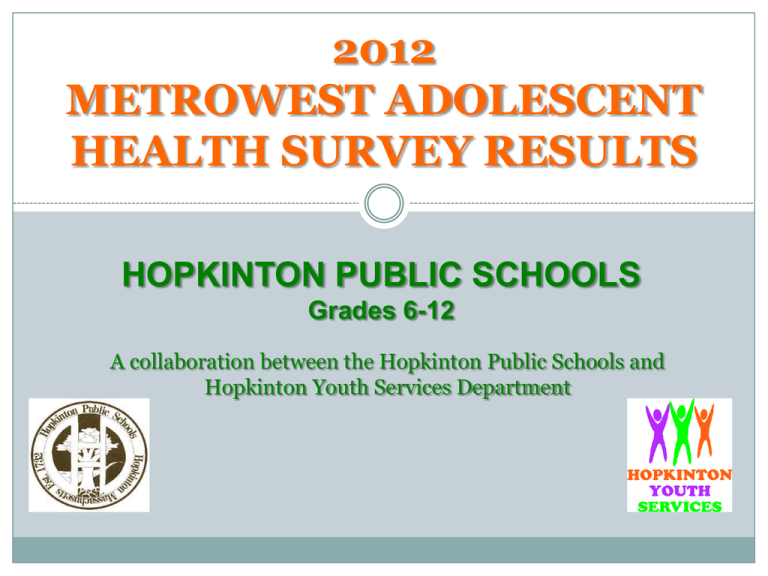
2012 METROWEST ADOLESCENT HEALTH SURVEY RESULTS HOPKINTON PUBLIC SCHOOLS Grades 6-12 A collaboration between the Hopkinton Public Schools and Hopkinton Youth Services Department MetroWest Adolescent Health Survey 2012 Participants: Dr. Cathy MacLeod Superintendent of Schools Dr. Mary Ann DeMello Assistant Superintendent of Schools Evan Bishop, MS High School Principal Alan Keller, MS Middle School Principal Jane Gomes, MA, LMHC Counseling / Adjustment Counselor Phil Powers, SRO Hopkinton Police Department Jean Vallera Vazza, M.Ed. Bruce Elliott, MS, CSCS, FNS Hopkinton Youth Services Coordinator Wellness Teacher / Subject Matter Leader (K-12) MetroWest Adolescent Health Survey 2012 Benefits of MetroWest Health Foundation Survey The MetroWest Youth Risk Behavior Survey is a 10 year initiative of the Massachusetts based MetroWest Health Foundation. The goal is to address adolescent health needs in the MetroWest region (25 communities & 40,000 students). Large amount of student data enables each district to consider differences in behavioral reports by gender and grade (6-12). Identifies emerging health issues that are Hopkinton specific versus MetroWest region. Results guide prevention strategies and lead interventions. Hopkinton Schools Participation Survey Key Facts Survey content based on the Center for Disease Control and Prevention (CDC) and the Massachusetts Youth Risk Behavior Survey (MYRBS). Survey is self administered, voluntary, and anonymous. Middle School: 748 students grade 6-8, representing 95% of students. High School: 1069 students grades 9-12 representing 95% of students. Next MWAHS administration will be Fall 2014. MWAHS – 7 Risk Categories Substance Use (tobacco, alcohol, illegal substance use, and prescription misuse) Violence (weapons, physical fighting, bullying and cyber bullying) Behaviors related to Unintentional Injuries (seatbelt use, helmet use, and drinking and driving) Sexual Behaviors related to Unintended Pregnancy and Sexually Transmitted Infections Mental Health (Stress, Depression, Self Injury, Suicidal Ideation, Suicide Attempts) Dietary Behaviors and Physical Activity School Attachment and Adult Support Middle School Survey Results Survey is self administered, voluntary, and anonymous. Middle School: 748 students grade 6-8, representing 95% of students. Middle School Alcohol Use Patterns: 9% of students drank alcohol in their lifetime, 4% drank in the past 30 days, and 1% reported recent binge drinking. More males than females initiate alcohol use in during the middle school years (13% compared with 5%). Alcohol use increases substantially by grade: Lifetime use increases from 2%in 6th grade to 16% in 8th grade. Trend: Lifetime alcohol use among middle school youth remained steady from 2010 to 2012 at 12% after decreasing from a high of 26% in 2008. Middle School Marijuana & Inhalants Marijuana: 2% of youth have used marijuana in their lifetime, and 2% of youth used marijuana in the past 30 days. Males are slightly more likely than females to initiate marijuana use (3% compared with 1%). Inhalants: 5% of youth used inhalants in their lifetime (defined as sniffing glue, breathing the contents of spray cans, or inhaling any paints or sprays to get high). Lifetime inhalant use increases from 6th grade (3%) to 8th grade (8%). Middle School Bullying & Cyber-Bullying Bullying: 31% of youth have been bullied in the past 12 months, and 25% have been bullied on school property. 15% of students report bullying other students. 31% of youth have intervened as bystanders and 10% have told an adult at school that someone else was being bullied. Cyber-Bullying: 13% of youth report being victims of cyber-bullying in the past 12 months, and 6% report cyber bullying someone else. Females are more likely to report cyber-bullying victimization (16% compared with 10%) while reports of cyber-bullying are similar among males and females. Middle School Mental Health Patterns: 10% of students reported that their life was “very” stressful in the past 30 days. 9% reported depressive symptoms and 6% reported self-injury. 8% of youth said they had considered suicide in their lifetime, and 1% had made a suicide attempt. Females are more likely than males to report recent stress (13% compared with 7%). Reports of self-injury and suicidality do not differ substantially by gender. Reports of stress, depressive symptoms, and self-injury increase from 6th to 8th grade. Trend: (Grades 7-8) Reports of mental health problems decreased slightly from 2008 to 2012 and are now similar to 2006 levels . Reports of depressive symptoms decreased from 19% in 2008 to 11% in 2012, and are similar to 2006 reports (13%). High School Survey Results Survey is self administered, voluntary, and anonymous. High School: 1069 students grades 9-12 representing 95% of students. High School Alcohol Use Patterns: 51% of students drank alcohol in their lifetime, 28% drank in the past 30 days, and 16% reported recent binge drinking. Alcohol use increases substantially by grade: Current drinking increases from 13% in the 9th grade to 58% in 12th grade. 16% of students report being a passenger in a car driven by someone who had been drinking alcohol in the past 30 days. Trends: Drinking in high school has declined. From 2006 to 2012, lifetime alcohol use decreased from 63% to 51% and current us decreased from 34% to 28%. Binge drinking remained similar from 2006 to 2010 at 19-21%, and then decreased to 16% in 2012. High School Marijuana Use Patterns: 30% of youth have used marijuana in their lifetime, and 21% used marijuana in the past 30 days. Males are more likely than females to initiate marijuana use (36% compared with 24%) and report recent use (27% compared with 15%). Trend: Lifetime marijuana use increased from 30% in 2006 to 37% in 2010, and then decreased to 30% in 2012. N-1069 = 9% High School Bullying Pattern: 28% of teens have been bullied in the past 12 months, and 23% have been bullied on school property. More females than males are victims of bullying and cyber-bullying. Reports of bullying decrease during the high school years, from 40% in 9th grade to 19% in 12th grade. Trends: Reports of bullying on school property decreased from 30% in 2008 to 23% in 2012. 31% in 2008 to 19% in 2012. During this time, victimization among females decreased slightly from 29% to 26%. High School Cyber-Bullying Patterns: 24% of youth report being victims of cyber-bullying in the past 12 months, and 11% report cyber-bullying someone else. Females are more likely than males to be cyber-bullying victims. However, reports of cyber-bullying perpetration are similar by gender. Trends: More youth are reporting cyber-bullying: Victimization has increased from 13% in 2006 to 24% in 2012. The increase in cyber-bullying victimization is greater among females (from 15% in 2006 to 30% in 2012) than males (from 11% to 18%). Slide for US on bullying & cyber-bullying - Jean High School Mental Health Patterns: 29% of students reported that their life was “very” stressful in the past 30 days. 18% reported depressive symptoms in the past 12 months (defined as feeling sad or hopeless for two or more weeks in a row). 15% of youth reported self-injury (defined as cutting, burning, or bruising oneself on purpose) in the past 12 months. Reports of stress range from 22% to 39% during the high school years and are highest in 12th grade. Trend: Overall reports of mental health problems have remained similar from 2006 to 2012. Strategies for Improvement Curriculum: Michigan Model for Health (K-12) Skills based curriculum founded by Central Michigan University Linking grades levels in 5 keys areas: (Social & Emotional, Physical & Nutrition, Safety, Illicit Substances, and Personal Wellness) Faculty initiatives and correspondence Middle & High School Staff weekly bulletins regarding data to better understand student needs District Safety Committee District Wellness Committee Crisis Response Team School Resource Officer Helpline - (508-293-1191) Strategies for Improvement Middle School Initiatives MWHF Anti-Bullying Grant Staff training – “Where Everybody Belongs” (WEB) MIAA – “YOU LEAD” Conference (Student Based) Stand Up to Bullying (MARC) – Student delegation attending Middlesex Partnerships for Youth – “Empowering Girls” High School Improvement Plan Guest speaker on stress 2nd Semester “I WILL” campaign to minimize student harassment Mini-Health survey in December - 850 HS student responded Measures to address bullying & cyber-bullying and student stress Planned activities to engage and lighten stress levels over the 2nd half of year Strategies for Improvement Hopkinton Youth Services Juvenile court diversion in conjunction with D.A. and SRO Prevention based work with civic and youth serving organizations Parent educational coffees facilitated in homes Youth Commission initiatives Wellness Fair, March 8th, 2014 Opportunity for community to engage in interactive dialogue regarding MWHAS key indicators Questions For more information: hopkintonma.gov/youth & hopkintonma.gov/wellness Please contact feel free to contact: Bruce Elliott @ belliott@hopkinton.k12.ma.us Teacher / Wellness Subject Matter Leader (K-12) (508) 497-9820 x 1136 Jean Vazza @ jvazza@hopkintonma.gov Hopkinton Youth Services (508) 497-9781 Thank You




